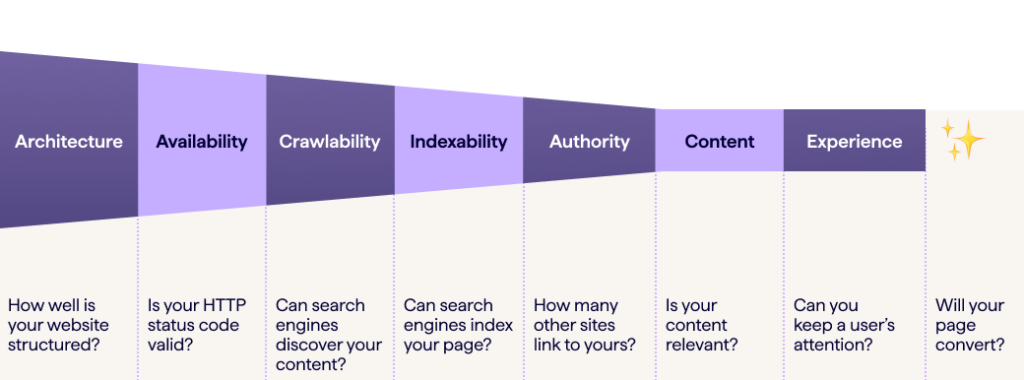The customer (or buyer) journey is a term that marketers have become very familiar with over recent years. But how exactly do SEO and your website’s technical health play a part in this journey?
We all understand that customers buying our products and solutions generally don’t do so on a whim. They very often research their options, ask colleagues, peers or friends for recommendations, check out analyst quadrants and customer review sites, watch short demos, and even take up free trials… all before they actually commit to purchasing.
What stands out the most about this purchasing phenomenon is that a large percentage of the ‘customer journey’ takes place online.
In fact, for some eCommerce brands, 100% of the customer journey can be online. For B2B companies, that figure has been steadily increasing as well, with 74% of business buyers surveyed telling Forrester that they conduct more than half of their research online before making an offline purchase.
With so much of the buying process taking place online, it makes sense that marketing teams spend so much of their time developing and refining their websites to better influence the buyer journey. It’s also why in recent years, big brands have been investing so heavily in content marketing to add gravitas to their websites and help with search rankings.
But while content and keywords are the go-to for marketers looking to improve their site’s rankings these days, their websites’ technical health is one aspect that can often go overlooked. It shouldn’t be. The technical health of a site (and related technical SEO improvements) can have a big impact when it comes to ranking highly on Google and other search engines — and for ensuring your brand is discoverable by potential customers. The overall ease of use and speed of your site can make a big difference on conversions to boot.
It’s no good having all that great content on your site if customers can’t find it. And one of the reasons they can’t find it? Your website’s SEO and technical health need to be prioritized.
Why is the customer’s journey / buyer’s journey so important?
To understand more about how your website’s SEO and technical health play a major part in your marketing strategy, it’s worth taking a step back to clarify why the customer or buyer’s journey is so important.
The customer journey (also known as the buyer’s journey) is a series of actions that your customer takes before – and after – they make a purchase.
Whilst this journey has traditionally been visualized in marketing as a linear journey, the challenging part for many marketing teams is that it’s not quite that simple.
Customers follow messy paths – they may start off in Google, then they’ll do some research in an online forum, and they may come across your brand in either of these places. But then they may do another Google search, watch a few seconds of a product video on YouTube, and finally start a 10-day free trial.
Nevertheless, the journey as a concept – and even as a visualized linear path – is a useful framework with which to plan your marketing as it provides insights into what your customer could potentially be doing before purchasing your product or service, and it allows marketing teams to plan for these actions with specific marketing activities, channels and content.
What are the stages of the buyer’s journey?
The buyer’s journey might seem complex, but leveraging stages helps to simplify the mess.
Traditional advertising models center around the AIDA framework –
- Awareness
- Interest
- Decision
- Action
(And ‘traditional’ is very apt here — this framework dates back to 1898!)
Years later, marketing professor Philip Kotler proposed a new framework: the 5 As –
- Awareness
- Appeal
- Ask
- Act
- Advocacy
More recently, many marketers have adopted an even more simplified approach to the buyer’s journey:
- Awareness
- Consideration
- Decision
This more simplified approach strikes a good balance between structure and flexibility, allowing for the fact that customers may move back and forth between these stages at any point.
Essentially, customers don’t follow a rigid path from awareness to interest, or from decision to action. Instead, they will:
1. Recognize a problem they have and carry out some research to see what solutions are available to fix that problem. Or, not know that they have a problem, and become aware of it from seeing or hearing some form of prompt. This is what we broadly call the AWARENESS stage in the buyer’s journey.
2. Start researching in more detail the specific products or services available that fit with the solution they’re after. Here, consumers will be looking at which companies offer these products or services, how they’re rated by others, and potentially how the solution actually works in practice. This is what we refer to as the CONSIDERATION stage.
3. Finally, the customer will start shortlisting and investigating in more depth how each product or service works. They’ll also be either consciously or subconsciously noting how the buying experience goes and how it makes them feel. Here we are at the DECISION stage.
How your website’s SEO and technical health impacts each stage of the buyer’s journey
These days, each stage of the buyer’s journey typically involves the customer taking at least some degree of online or digital action. And regardless of where that customer has originated from online – be it a Google search, a Slack community, or a Facebook ad – most of the time, you’ll want them to ultimately land on your website.
To ensure you’re giving your website the best chance of being seen — and even to reduce the amount of investment it takes for the customer to eventually get to your site — you need to prioritize your website’s SEO and technical health.
Here’s how to go about doing this at each stage of the buyer’s journey.
Awareness Stage
There’s very little point in creating great content for your site if it doesn’t get seen by your customer. And with a huge number of online consumers turning to Google and other search engines for just about any question they may have, search engine optimization (SEO) is a key way for customers to find your business’s website.
At Lumar, we’ve written before about the SEO-Revenue Funnel, as you can see below. This framework helps illustrate how the different aspects of SEO can ultimately contribute to the end goal: conversions and revenue.
Because a core goal of SEO is to make your site discoverable in people’s search engine results pages (SERPs), optimizing your site for search can have a massive impact on brand awareness. Succeeding in every stage of the SEO funnel above helps improve your rankings, which means all of the stages of the funnel collectively impact the awareness stage of the customer journey.
One part of SEO that is often overlooked by marketers is technical SEO. It shouldn’t be. Your site’s technical health can really contribute to how well it ranks in search engines — and thus, to brand visibility and discoverability.
Technical SEO is a foundational stage of any SEO strategy that involves establishing a technically sound, high-performing website.
To ensure you’re addressing your site’s technical health to rank better in organic search and drive more brand awareness, make sure you’re monitoring all of the stages of the SEO funnel and have addressed:
- Site Architecture: A well-structured website that search engines will recognize and organize.
- HTTP Availability: Pages with valid HTTP status codes.
- Crawlability: Content that is discoverable by search engines.
- Indexability: Pages that can be indexed by search engines.
- Authority: Content that has authority, or pages that include reputable backlinks.
- Content: Content that is relevant to the customer’s original search query and is technically bolstered by structured data, image alt tags and similar, to better rank in search.
- Experience: Your site should load quickly, be visually stable, and have interactive elements that work correctly, i.e., it should adhere to Google’s Core Web Vitals.
Consideration Stage
As your customer moves through the buyer’s journey into the consideration stage, you’ll want to keep them engaged with your offering and stay top-of-mind as they encounter other options for businesses to purchase from. That means getting them back to your website multiple times so you can reinforce your message with yet more great content!
It also means making sure prospective customers don’t get distracted by a competitor’s site, so when implementing SEO to support the consideration stage of the buyer’s journey, a competitive SEO analysis can play a critical part. This means creating and optimizing pages that will rank well alongside the keywords that your competitors also rank for.
Referring back to the SEO-Revenue Funnel, we’re once again looking at a number of important funnel steps that are at play in the consideration stage of the buyer’s journey because all of the SEO funnel elements will help you rank your content alongside competitors in the search results. However, the most critical in terms of influencing individuals’ consideration at this stage are your site’s Content, Authority, and Experience.
Decision Stage
We named the SEO-Revenue Funnel the way we did for a reason! Most business websites are, ultimately, about generating revenue. Even in complex B2B buying cycles where the conversion often happens offline, a lot of the work that has led up to that conversion will have involved your website.
To optimize revenue generation online and really influence potential customers during their decision phase, you need to prioritize:
- An easy-to-navigate website so prospective customers can find the exact information they need to support their buying decision (Site Architecture).
- Authoritative and trustworthy content that provides relevant, persuasive information to help customers decide to buy (Topical Authority & Website Content).
- A great user experience, including fast-loading pages and minimal friction in customers’ interactions with your site (Page Experience).
- Page conversion optimization (CRO, Conversion Rate Optimization).
Across all of three stages of the buyer’s journey — but particularly in the decision stage — providing the customer with a seamless and friction-free conversion or buying experience is paramount. This is where site speed and other ‘Core Web Vitals’ come in.
In fact, a 2019 report by Unbounce showed that nearly 70% of consumers admitted that page speed impacts their willingness to buy from an online retailer.
If you’re on the hunt for a site speed benchmark to aim for, according to a study by Portent, a 0 – 4 second speed is best for conversion rates.
Deloitte has also republished user performance data from Google on page 8 of their “Milliseconds Make Millions” report, showing the impact that page load has on customer focus and interaction – from 0 milliseconds, all the way up to 10,000+.
The reality might be somewhat different from the ideal, though. Taking a look at shopping sites in particular, Think with Google states that the average load time is currently 15.3s for a mobile page.
Now compare that against the benchmark speed we’ve just quoted, and then think about how many more conversions you could make just by being quicker than your competitors!
Final thoughts: How SEO & website health impact the customer journey
It goes without saying that we’re in a ‘search-first’ age of buying, and it’s a trend that shows no signs of disappearing anytime soon.
The majority of our customers are likely to self-educate, not only on what their problems are, but also on what solutions are available to help them address those problems.
It’s a trend that has shown even further growth in the past few years. Before the pandemic, Google processed over 3.5 billion searches per day. In the first year of the pandemic, this figure jumped to 6.9 billion per day. And in 2022, it was up again to 8.5 billion searches a day.
Savvy marketing leaders know that taking advantage of this search-first era means combining a seamless customer experience with great content, a shift that many marketing teams have mastered exceptionally well in recent years.
Looking to the immediate and long-term future, however, leading marketing teams know that both of these strategic factors rely heavily on a high-performing website. A website with strong technical foundations and optimized SEO that is sure to beat off the competition and keep your brand top of mind for the customer.







